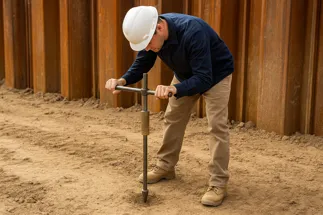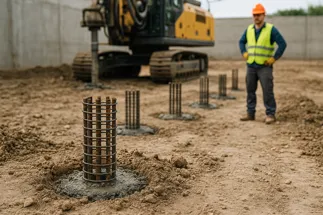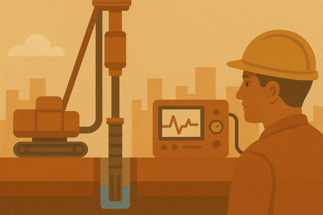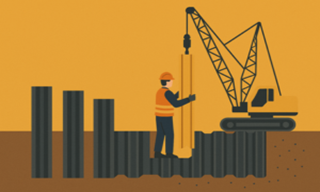How to Prepare Your Site for High Strain Dynamic Pile Testing
When it comes to constructing a robust foundation for infrastructure projects like bridges, high-rise buildings, or offshore platforms, ensuring the integrity and load-bearing capacity of deep foundation piles is critical. High Strain Dynamic Pile Testing (HSDT) is a powerful, non-destructive method used to evaluate the performance of piles by subjecting them to high-impact loads. This testing technique provides engineers with essential data on pile capacity, structural integrity, and soil response, making it a cornerstone of modern geotechnical engineering. However, the success of High Strain Dynamic Pile Testing hinges on meticulous site preparation. In this blog, we’ll walk you through the key steps to prepare your construction site for HSDT, ensuring accurate results and a smooth testing process.
Step 1: Conduct a Thorough Site Assessment
The first step in preparing for High Strain Dynamic Pile Testing is a comprehensive site assessment. This involves evaluating the site’s accessibility, soil conditions, and pile specifications. Ensure the site is clear of obstructions that could interfere with testing equipment, such as debris, heavy machinery, or temporary structures. Accessibility is crucial because the testing crew will need to bring in heavy equipment, including cranes, drop hammers, and the PDA system.
Additionally, review the geotechnical data from borehole samples or site investigations to understand the soil profile. This information helps determine the appropriate hammer size and drop height for the test, as well as the expected pile behavior. For instance, piles embedded in clay soils may require different testing parameters than those in sandy or rocky conditions. Consulting with a geotechnical engineer during this phase can prevent costly oversights and ensure the testing setup aligns with the site’s unique characteristics.
Step 2: Prepare the Pile for Testing
Proper pile preparation is critical for accurate High Strain Dynamic Pile Testing results. The pile head must be accessible, clean, and structurally sound to withstand the impact of the hammer. Here’s how to get it ready:
- Clean the Pile Surface: Remove any loose concrete, soil, or debris from the pile head. For bored piles, chip away any weak or cracked concrete to expose a solid, flat surface. A grinder may be used to smooth the surface, ensuring a firm connection for sensors.
- Extend the Pile Head (if Needed): In some cases, the pile head may need to be extended to accommodate sensor placement. For bored piles, the extension should match the pile’s diameter, reinforcement, and concrete grade to avoid cracking during testing. Typically, the pile head is extended to at least 1.6 times the pile diameter above the ground.
- Add a Pile Top Cushion: To protect the pile head from damage during high-impact testing, place a cushion, such as plywood sheets (25–50 mm thick), on top of the pile. The cushion absorbs some of the impact energy, reducing the risk of cracking. The test engineer will specify the cushion thickness based on the pile type and hammer weight.
For driven piles, testing can be conducted during or after installation, while bored piles often require additional preparation, such as constructing a pile cap with the same properties as the main pile body. Ensuring the pile is properly prepared minimizes errors in sensor readings and protects the pile from damage.
Step 3: Select and Calibrate Testing Equipment
High Strain Dynamic Pile Testing relies on specialized equipment, including a drop hammer or pile driving hammer, strain transducers, accelerometers, and a Pile Driving Analyzer (PDA). The choice of hammer is critical—its weight should typically be 0.7% to 4% of the static test load to generate sufficient force for accurate measurements.
Before testing begins, calibrate all sensors to ensure precision. Strain transducers and accelerometers should be securely attached to the pile, typically 1.5 to 2 pile diameters below the pile head, on opposite sides to account for any bending during impact. The sensors are usually bolted or welded to mounting blocks to prevent slippage. The PDA system, such as the one offered by industry leaders like Grimtech, should be set up to record and process data in real time, providing immediate insights into pile performance.
It’s also important to verify that the testing equipment complies with standards like ASTM D4945, which outlines the requirements for High Strain Dynamic Pile Testing. A qualified testing engineer should oversee the setup and calibration to ensure the equipment is functioning correctly and the test setup is optimized for the site conditions.
Step 4: Coordinate with the Testing Team
Effective communication with the testing team is essential for a successful HSDT process. Before testing begins, schedule a meeting with the testing consultant, geotechnical engineer, and site contractor to review the testing plan. Discuss key details, such as:
- The number of piles to be tested (preliminary test piles or working piles).
- The timing of the test (during pile driving for driven piles or after installation for bored piles).
- The expected load and hammer drop height.
- Safety protocols to protect personnel and equipment during testing.
The testing team should also provide a method statement outlining the test procedure, equipment setup, and data analysis process. This document ensures everyone is aligned on the testing objectives and procedures. For example, the method statement might specify that testing should occur at least 15 days after pile installation to allow the concrete to reach the required compressive strength.
Step 5: Ensure Site Safety and Accessibility
Safety is paramount during High Strain Dynamic Pile Testing due to the heavy equipment and high-impact forces involved. Clear the testing area of non-essential personnel and equipment, and establish a safety perimeter around the test pile. The testing process generates significant noise and vibrations, so notify nearby workers or residents to minimize disruptions.
Ensure the site is accessible for the testing crew to maneuver cranes, hammers, and other equipment. For offshore or coastal projects, additional planning is needed to accommodate the unique challenges of marine environments, such as securing the drop weight mechanism and ensuring stable platforms for equipment. A well-prepared site reduces the risk of delays and enhances the safety of the testing process.
Step 6: Plan for Data Collection and Analysis
High Strain Dynamic Pile Testing generates a wealth of data, including force and velocity measurements, pile stresses, and soil resistance. To make the most of this data, ensure the testing team is equipped with advanced analysis tools like CAPWAP, which simulates static load test results based on dynamic measurements. The PDA system provides real-time feedback, allowing engineers to adjust testing parameters if needed.
After testing, the team will generate a comprehensive report summarizing the pile’s capacity, integrity, and any detected anomalies. This report is critical for validating design assumptions and ensuring the foundation meets project specifications. Review the report carefully with the testing consultant to understand the results and their implications for the project.
Step 7: Address Common Challenges
Even with thorough preparation, challenges can arise during High Strain Dynamic Pile Testing. Here are a few common issues and how to address them:
- Inadequate Pile Movement: If the pile doesn’t move sufficiently (e.g., less than 2–4 mm per blow), the test may underpredict the pile’s capacity. Increase the hammer drop height or adjust the testing parameters in consultation with the engineer.
- Sensor Misplacement: Improperly placed sensors can lead to inaccurate readings. Ensure sensors are positioned symmetrically and securely attached to the pile.
- Site Constraints: Limited space or difficult terrain can complicate equipment setup. Plan ahead by clearing the site and coordinating with the testing team to use compact or specialized equipment if needed.
By anticipating these challenges and addressing them proactively, you can ensure a smoother testing process and more reliable results.
Why Proper Preparation Matters
Investing time and effort in preparing your site for High Strain Dynamic Pile Testing pays off in multiple ways. It ensures the accuracy of the test results, which are critical for verifying the pile’s load-bearing capacity and structural integrity. Accurate data helps optimize foundation design, reduce material waste, and prevent costly rework. Additionally, proper preparation enhances safety, minimizes project delays, and ensures compliance with industry standards like ASTM D4945.
Whether you’re working on a high-rise building, a bridge, or an offshore platform, HSDT is a valuable tool for ensuring the reliability of your foundation. By following these steps—conducting a site assessment, preparing the pile, calibrating equipment, coordinating with the testing team, ensuring safety, and planning for data analysis—you can set the stage for a successful testing process.
Conclusion
High Strain Dynamic Pile Testing is a proven method for evaluating the performance of deep foundation piles, offering insights that static load tests may not provide in a cost-effective and timely manner. However, its success depends on careful site preparation, from clearing the site and preparing the pile to calibrating equipment and ensuring safety. By taking a methodical approach and working closely with a qualified testing team, you can maximize the benefits of HSDT and lay a solid foundation for your project. With the right preparation, you’ll gain confidence in your pile’s performance and ensure the safety and durability of your structure for years to come.
FAQ:
Q1. What is High Strain Dynamic Pile Testing?
High Strain Dynamic Pile Testing, also called HSDT, is a method used to check if a foundation pile can carry the required load. It uses a hammer to apply force to the pile and sensors to record data about pile strength, soil condition, and overall safety.
Q2. Why is site preparation important for pile testing?
Proper site preparation makes sure the test is accurate and safe. If the site is clear and easy to access, the testing team can set up equipment quickly and collect correct data without delays or errors.
Q3. How do I prepare my site for High Strain Dynamic Pile Testing?
First, clear the site of debris, machinery, and any obstacles. Check the soil condition with a geotechnical engineer. Make sure cranes and hammers can reach the piles easily. This saves time and prevents problems on the day of testing.
Q4. How should I prepare the pile head for testing?
Clean the pile head so it is flat and solid. Remove any loose concrete or soil. If needed, extend the pile head to the right height and add a cushion (like plywood sheets) to protect it from hammer blows.
Q5. What kind of equipment is used in HSDT?
The team uses a heavy hammer, strain sensors, accelerometers, and a Pile Driving Analyzer (PDA) to record the results. All equipment should be checked and calibrated before testing to meet standards like ASTM D4945.












Leave a Reply